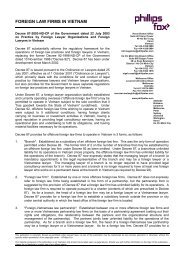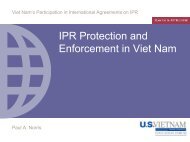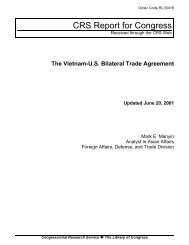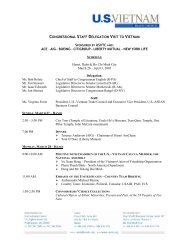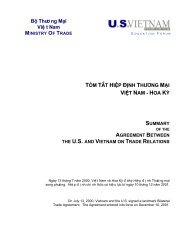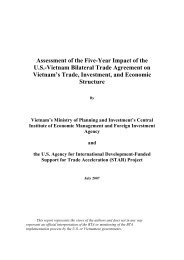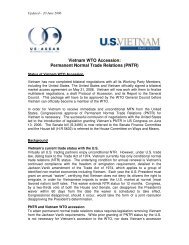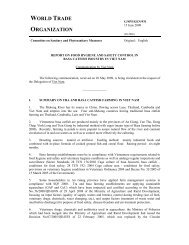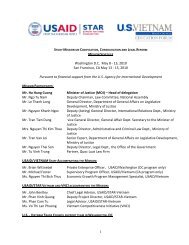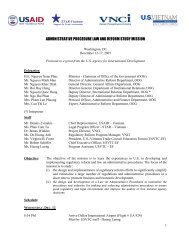Climate risks and adaptation in Asian coastal megacities: A synthesis
Climate risks and adaptation in Asian coastal megacities: A synthesis
Climate risks and adaptation in Asian coastal megacities: A synthesis
- No tags were found...
You also want an ePaper? Increase the reach of your titles
YUMPU automatically turns print PDFs into web optimized ePapers that Google loves.
activities that are be<strong>in</strong>g considered <strong>in</strong> the Royal IrrigationDepartment master plan are <strong>in</strong>frastructureactivities (such as construction <strong>and</strong> improvement ofcanals, dikes, pump<strong>in</strong>g stations, etc.). Flood<strong>in</strong>g ofagricultural l<strong>and</strong>s upstream of Bangkok is utilizeddur<strong>in</strong>g major floods to help attenuate the flood peak,lower<strong>in</strong>g the flood profile <strong>in</strong> Bangkok.Current <strong>and</strong> planned l<strong>and</strong> use <strong>and</strong> urbanplann<strong>in</strong>g <strong>in</strong> Bangkok—Bangkok <strong>in</strong> the futureThe Bangkok study projected what the city wouldlook like <strong>in</strong> the future based on a wide range ofavailable data about population <strong>and</strong> growth <strong>and</strong> anumber of sectoral <strong>and</strong> urban development plans(Box 3.1). Modern urban l<strong>and</strong> use plann<strong>in</strong>g <strong>in</strong>Bangkok started <strong>in</strong> the 1950s. Bangkok’s <strong>in</strong>ner cityconta<strong>in</strong>s the Gr<strong>and</strong> Palace, government offices, majoruniversities <strong>and</strong> educational establishments, <strong>and</strong>2-to-4-story row houses that are used as commercial<strong>and</strong> residential units. The <strong>in</strong>ner city is a nationalhistoric conservation area where construction ofhigh-rise build<strong>in</strong>gs is prohibited. Urban growth <strong>in</strong>Bangkok, however, has progressed <strong>in</strong> a sometimesad hoc manner <strong>and</strong> without a unified plan l<strong>in</strong>k<strong>in</strong>git to the surround<strong>in</strong>g areas. To remedy this problem,the government has developed a 50-year regionalspatial plan (f<strong>in</strong>ished <strong>in</strong> 2007) that foresees growthof the surround<strong>in</strong>g areas. This plan also providesfor significant environmental protection <strong>and</strong> wetl<strong>and</strong>areas.<strong>Climate</strong> change parameters—statisticaldownscal<strong>in</strong>gFor the 2050 simulations, the Bangkok City casestudy applied the statistical downscal<strong>in</strong>g factorsestimated by the University of Tokyo’s IntegratedResearch System for Susta<strong>in</strong>ability Science (IRS3)discussed <strong>in</strong> chapter 2. Given the size of the ChaoPhraya watershed <strong>and</strong> the long time it takes upperwatershed ra<strong>in</strong>fall to reach Bangkok as stream flow,the team applied the mean <strong>in</strong>crease <strong>in</strong> seasonalprecipitation (3 percent <strong>and</strong> 2 percent for A1FI <strong>and</strong>B1 respectively) to the three-month ra<strong>in</strong>fall eventsfor the correspond<strong>in</strong>g 1-<strong>in</strong>-10, 1-<strong>in</strong>-30 <strong>and</strong> 1-<strong>in</strong>-100-year precipitation events for the watershed. Thesetotal precipitation levels were distributed over thewatershed us<strong>in</strong>g spatial <strong>and</strong> temporal patterns fromhistoric flood years. The forecasted temperature<strong>in</strong>creases of 1.9 ° C <strong>and</strong> 1.2 ° C for the A1FI <strong>and</strong> B1scenarios respectively for 2050 were used <strong>in</strong> the hydrologicalmodel<strong>in</strong>g. The SLR estimates used were0.29 m <strong>and</strong> 0.19 m for the A1FI <strong>and</strong> B1 scenariosrespectively. This was based on IPCC AR4 (Work<strong>in</strong>gGroup 1, Chapter 10, Table 10.7) estimates. It wasdecided to use half of the 2099 <strong>in</strong>crease for the 2050estimates; namely, 0.29 m <strong>and</strong> 0.19 m for the A1FI<strong>and</strong> B1 scenarios respectively.Box 3.1 ■ The Bangkok MetropolitanRegion (BMR): SomeAssumptions about theFutureBangkok is chang<strong>in</strong>g rapidly <strong>and</strong> some of these changes havebeen taken <strong>in</strong>to account <strong>in</strong> model<strong>in</strong>g the future. Bangkok is<strong>in</strong>creas<strong>in</strong>gly “suburbaniz<strong>in</strong>g.” Between 1998 <strong>and</strong> 2003, BMR sawa 74 percent <strong>in</strong>crease <strong>in</strong> urban development. The city’s hous<strong>in</strong>gstock has doubled <strong>in</strong> the last decade. This trend is expected tocont<strong>in</strong>ue. The Government’s L<strong>and</strong> Use Plan for 2057 is used toproject the number of commercial, residential, <strong>and</strong> <strong>in</strong>dustrialbuild<strong>in</strong>gs <strong>in</strong> Bangkok <strong>in</strong> 2050. Available government plans aretaken <strong>in</strong>to account <strong>in</strong> establish<strong>in</strong>g future road <strong>and</strong> transportationnetworks. Plans suggest tightened urban areas with<strong>in</strong> a networkof expressways bounded by large environmental protection areasto divert any floods from the centers.Based on exist<strong>in</strong>g trends, the city of Bangkok is not expectedto grow a lot, while neighbor<strong>in</strong>g suburbs will cont<strong>in</strong>ue to grow.For <strong>in</strong>stance, suburban Nonthaburi <strong>in</strong>creased its population by47 percent dur<strong>in</strong>g 2002–07. Bangkok City is expected to have apopulation of 10.55 million (4.65 million households) <strong>and</strong> BMR apopulation of nearly 16 million by 2050. To forecast the population<strong>in</strong> 2050 for BMR, <strong>in</strong>formation on population projections for Thail<strong>and</strong>2003–30 prepared by the government (NESDB) was used as a base.The NESDB report projects population to the year 2030 for the wholek<strong>in</strong>gdom <strong>and</strong> to 2025 <strong>and</strong> 2020 for Bangkok <strong>and</strong> other prov<strong>in</strong>cesrespectively. In project<strong>in</strong>g the population to 2050, a regressionfunction was applied.In terms of the BMR economy, regional GDP is projected for twoareas (Bangkok <strong>and</strong> Samut Prakarn) of BMR most likely to be affectedby flood<strong>in</strong>g. GDP for Bangkok <strong>and</strong> Samut Prakarn <strong>in</strong> 2050 is expectedto be six-fold higher than the current GDP. In terms of poverty <strong>in</strong>the cities, <strong>in</strong> Bangkok <strong>in</strong> 2007 only 88,361 people (0.6 percent ofthe total) <strong>in</strong> the BMR were officially considered poor. However, thisnumber excludes some 768,220 people liv<strong>in</strong>g <strong>in</strong> 133,317 condensedhous<strong>in</strong>g units. In the flood impact assessment, the higher, moreaccurate number was used.Source: Adapted from Panya Consultants (2009).26 | <strong>Climate</strong> Risks <strong>and</strong> Adaptation <strong>in</strong> <strong>Asian</strong> Coastal Megacities: A Synthesis Report



